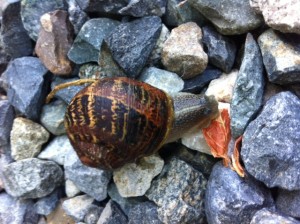Snails, snails and more snails
Posted on August 9th, 2012 by Phuong

Brown snail introduced from France in 1850s as food. Photos by Ecoyards.
I had the unpleasant task this morning of hand-picking about a dozen snails from my garden in Seattle. It seems like these little hungry creatures multiplied overnight, but in reality I’ve ignored my garden during these busy summer weeks and allowed the perfect conditions for the mollusks to grow. I left plenty of damp, hiding spots for them, and plenty of overhanging weeds; for example, I left a tarp in one corner of the garden, which provided perfect cover for the snails to grow and I’m growing plants they particularly love.
Common brown garden snails, otherwise known as Cornu aspersum or Helix aspersa) are a menace because they feast on both living and decaying plants, and they grow rapidly. Plus they’re kind of slimy and gross. Brown snails were brought to California in the 1850s by the French as food (yum, escargots). They love young tender shoots and seedlings, and herbaceous plants that grow close to the ground (strawberries, artichokes, tomatoes). They also like to eat lettuce, marigolds, dahlia, beans, basil, and other veggies. They don’t like woody ornamental plants, such as lavender, rosemary, sage, geraniums, begonias and nasturtiums.

Snail’s mucus.
OK, so what can you do when you’re overrun by snails? Hand-pick them off your plants, fences and walls, and crush them. (This morning I threw them into a garbage bag, and tossed a few into the street for the birds). Hand-picking isn’t the most appealing method for those pest-adverse gardeners, but it really is the easiest and weirdly satisfying. In the past I’ve also tried trapping snails and slugs by putting out a little container of beer at ground level; I’ve never found beer-trapping to be that effective, but others report otherwise. You could also use a little sugar water and yeast to get the same effect. Your container should be deep enough so that snails don’t just crawl out of the sides. (There are plenty of YouTube videos describing how to make one of these beer traps). The experts at the University of California say such traps aren’t very effective for the amount of time it requires; you have to constantly replenish the beer (or other trapping liquid) and they only draw the pests within a few feet of the container.
If hand-picking and beer-trapping aren’t for you, studies have shown that copper barriers can work in repelling snails from containers and raised beds. Supposedly the copper works because the copper reacts with a snail’s slime and effectively “shocks” it and messes up its nervous system. You can wrap copper foil around a tree trunk or planting boxes to keep the mollusks away. If you use these barriers on planting boxes or raised beds, make sure you don’t have any snails or snail eggs inside the container before installing the barrier; one friend discovered that her copper barrier had trapped snails inside her raised bed.
Plenty of garden stores also sell snail baits that are toxic to snails, but the ones containing metaldehyde are also poisonous to cats and dogs. There are some baits containing iron phosphate (i.e. Sluggo) that are safe around children and wildlife. Read the directions carefully and time the use properly (they’re usually not as effective during very hot, very cold or very dry times of the year).
My take-away from this morning’s snail hand-picking session is to do a better job of keeping my garden clean. I’ll try to remove boards, weedy areas, stones, branches close to the ground where snails thrive. Unfortunately, my vegetable garden is located close to our fence and garbage cans, when boxes and such tend to pile up. Inevitably, snails will come even if you keep a clean garden, so hand-picking will be just another routine.
Filed under:Seattle Landscape Design, Seattle Landscape Maintenance, Vegetable Gardening | Permalink |



